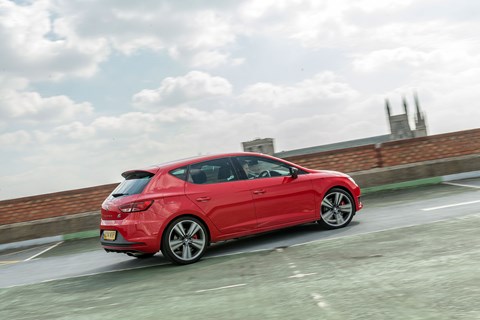► Long-term Seat Leon Cupra review
► Eight months in the top 280 model
► Faster than Golf GTI. But better?
Month 8 running a Seat Leon Cupra 280: the conclusion to our long-term test
Eight months, 11,355 miles, and two front tyres later, the Cupra 280 has gone.
It arrived showing 1698 miles, and I loved its angular lines. I could’ve chosen the three-door SC, but the five-door loses very little visually, so £300 extra was a no-brainer. When I first climbed in, I thought the seating position too high, the interior lacking in sparkle, the sat-nav too slow to wake up; I still do.
While the Golf R took a surprise gold in CAR’s hot-hatch slugfest, the Leon got a mauling. But I enjoyed it. I thought the ride firm if acceptably compliant, the steering precise and unexpectedly feelsome, and the engine was a peach, with its kick of mid-range juice and revvy enthusiasm.
I tried dual-clutch DSG and manual variants, and while 71% of buyers vote DSG, I felt the manual’s slick changes added to the experience. The Seat swung between short school runs, 60-80mph motorway cruising, occasional B-road antics and 40 minutes on Rockingham racetrack. So while the official 42mpg is a distant dream, I’m delighted with 32.9.
Traction will always be a challenge for a front-driver packing 276bhp, but the Leon uses a mechanical locking diff, and makes a decent fist of deploying power via a good set of tyres. On wet roads it’d scrabble, but it was on track that it disappointed most – perhaps explaining that early Cadwell Park verdict. It chewed tyres so quickly that I abandoned Rockingham before midday. Renault’s Megane RS might not do family duties so well, but it’s the trackday don – although I didn’t try the options that Seat later introduced: sticky Michelin Cup 2s, Brembo four-pots, bucket seats.
My track stint sealed the Bridgestones’ early passing, and traction became alarmingly poor when the tread was still very much legal. I swapped for Michelin Pilot Super Sports. But I never had to visit the dealer, top up the oil, or get a service.
VW has positioned the 280 interestingly compared with the Golf GTI, lavishing it with extra kit rather than slashing cost. So it gets adaptive dampers, LEDs, nav, the 19s – none standard on the GTI – but costs £275 more. Swapping between them shows the GTI still has a big wodge of mid-range shove, but the Leon feels stronger at higher rpms. Select the most aggressive settings and the Cupra’s engine note turns loud and synthetic, and I love the thunderclaps between gear changes.
The Seat’s similarly priced, more powerful, has more kit and is equally eye-catching. You’d be brave not to succumb to the Golf, but there’s plenty of reasons not to.
By Ben Barry
Click here to read CAR’s 11-month VW Golf GTI long-term review
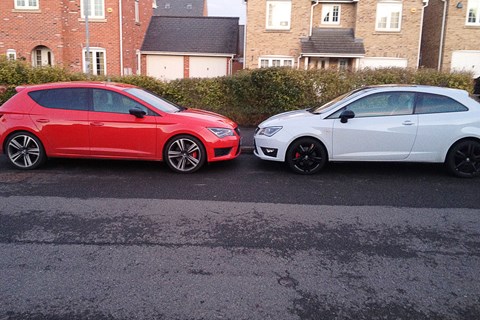
Month 7 running a Seat Leon Cupra: meet little bro
Borrowed the Leon’s sibling recently, the Ibiza Cupra. Verdict? The Leon is significantly more polished: steering, ride, transmission, equipment, refinement, performance, all are better. The Ibiza’s soft front end makes for some pretty hilarious lift-off oversteer, but the Fiesta ST can rest easy.
In other news, I found the postcode entry that I previously said the Leon doesn’t have. You have to select ‘town’ first, and it’s tucked away in the touchscreen keyboard. My mistake, but why no ‘postcode’ shortcut on the initial menu?
By Ben Barry
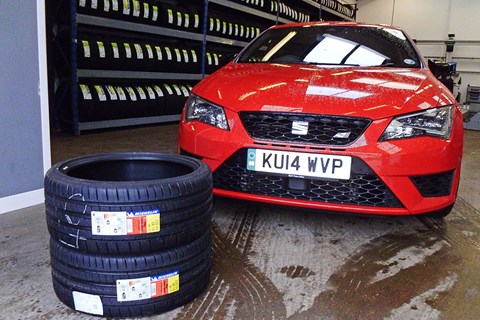
Month 6 running a Seat Leon Cupra 280: time for a tyre change
No surprises here, the Leon Cupra R is one of the fastest front-drive cars ever, and fast front-drivers munch front tyres. The recent Rockingham trackday effectively did for the standard 19-inch Bridgestone Potenzas – I drove for two 20-minute sessions, maybe half of that at full speed, but the damage was done.
The tyres weren’t illegal, so I stuck with them. But as the weather deteriorated with winter and the wear-markers edged closer, so I found myself able to access only a fraction of the Cupra’s performance. The tyres would spin up as the R’s torque-bomb detonated in a straight line, and I always felt slightly fearful leaning on them through quick, damp corners; when the understeer did strike, it made me yelp in that panicky way only understeer can.
I reckon I could’ve stretched the original tyres another two- or three-thousand miles, but you just need a good set of boots on cars like this, or much of their performance – and your enjoyment of it – is wasted. So I called Steve Bell at Airtek, who’s spent the last 12 years as a mobile tyre-fitter but has now put down roots with a shiny new premises in Stamford, Lincolnshire.
Airtek quoted £167.59 per Michelin Pilot Super Sport in 235/35 R19, with fitting, balancing and VAT. So I got the car booked in on a convenient Saturday and went easy on the throttle in the meantime.
Come the big day, Airtek had the tyres fitted in under an hour, and then it was time to head back onto the road to see the difference. The transformation is huge: the tyres now bite hard under heavy acceleration, so the thump and scrabble that’d often accompanied generous throttle in first, second and third is gone; it makes the Leon a far more civilised and enjoyable thing to drive, even when you’re not ‘on’ it. But when you are, it’s through the corners that you really appreciate the new tyres’ extra purchase. Michelin describes how the Pilot Super Sport’s contact patch is designed to shift about under load, while also ensuring the same amount of rubber always stays in touch with the road. There’s certainly a confidence-inspiring definition and consistency to the grip when you really lean on it, which is welcome after the will it/won’t it slip of the worn old boots; I particularly like how the tyres bite into the surface when you accelerate hard after the apex, where before the Cupra was limited by frustrating understeer. The Cupra R’s back to its best, then. When’s the next trackday?
By Ben Barry
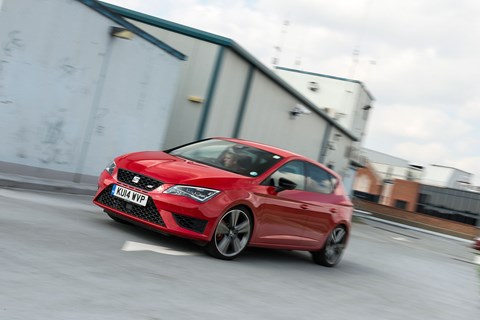
Month 5 running a Seat Leon Cupra 280: fast car, slow sat-nav
The Leon Cupra 280 will accelerate from 0-62mph in 5.8sec. That’s very fast for a five-door hatch, and Seat makes much of the stat in its promo material. But it doesn’t mention that this is a necessity because the sat-nav is so slow to fire up. It seems to vary, but I just popped outside and timed it at a yawning 50 seconds before I could input any commands into the touchscreen; by the time you’ve got going, you’ll need all 276bhp to make up for lost time. I know, it’s a first-world problem, but it’s annoying because turning on the ignition is the exact moment when you want the system to obey your commands; turn on car, enter postcode, drive to meeting.
Ah, that reminds me, the nav doesn’t take postcode entry. Instead, you need to enter the desired street, and the intersecting street. And when you’ve only got the address on an email or a bit of paper, well, you just end up taking pot luck from the suggested options, or having to enter the address into your smartphone maps and work out the intersecting street that way.
Instead, I’ve just been sticking my iPhone into a little cradle I bought that clips into an air vent, and using the navigation function on that. To be fair, Seat’s navigation is good once it’s woken up and you’ve got the address entered, and if you’re doing a regular trip, you just press ‘last destinations’; but then there’s a good chance you’ll know where you’re going anyway. I’d take a tenth or two off that 0-62mph time for a swifter sat-nav.
By Ben Barry
Month 4 running a Seat Leon Cupra 280: what’s the mpg, mate?
I recently drove for two hours on the motorway. Everyone managed a 60mph rush-hour cruise without crashing, and as traffic thinned, I saw 70mph with peaks of 80mph giddiness. At journey’s end, the onboard computer claimed 37.7mpg. Result! The Leon has a thumping 276bhp engine; it’s refined, tuneful and revs keenly when you’re on it. When you’re not, the torque swells like you’re surfing the Mavericks. It’s a great performance motor, one that’s worth a little sacrifice, and yet here it was claiming almost 38mpg.
Of course, we never trust fuel computers: we keep a little book and note down litres, £s and miles at every fill. So 6000 miles into our tenure seemed a good time to take stock of the total average. The calculator came back with 32.3mpg. I got a C in GCSE maths, so I did it again; same result.
During my custodianship, the Leon’s sat in very little traffic, mostly spinning freely on A-roads. But I’ve also ragged it along a few B-roads with the enthusiasm of a sixth-former flushing a year seven’s head down the lavatory, and driven it fast around Rockingham. Perhaps I should be complaining that we’re 25% off the official 42.2mpg, but I’m a tank-half-full kind of person; I’ll take 32mpg from a seriously quick car.
By Ben Barry
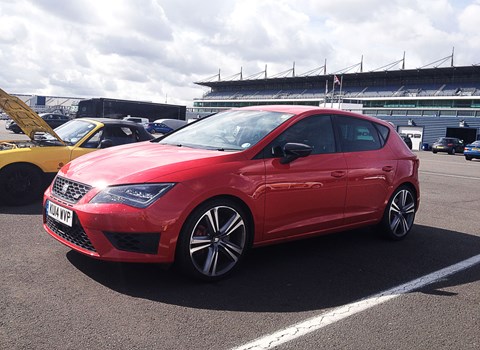
Month 3 running a Seat Leon Cupra 280: it’s track day time
You might recall that Seat briefly snatched the fastest front-drive Nürburgring time from the Megane Renaultsport, before Renault fought back with something more expensive and less practical. So it seemed apt to head to a trackday at Rockingham. It was to be held on the twisty, fast-paced infield, which I love, so I turned up on a sunny Saturday and listened to the briefing about only overtaking on the left and only on a straight and only when the driver in front indicates.
The first job was to disengage the stability systems. You have to trawl through sub-menus and, when you finally find the off button, it asks if you’re absolutely sure. There’s less chance of you stumbling on this sequence than a group of monkeys crafting Shakespearean verse, so when you press ‘yes’, you want everything off, right? Shame it still intervened when I was giving the throttle a quick lift through a fast section to cancel any understeer. The computer was sure I was a goner and bungled in there unannounced.
Still, things went well during the first stint, the Leon fast and stable and stoppable, and it lapped substantially faster than everything bar a Caterham 400, which it trailed by a second or so.
This wasn’t an open pitlane event, 20-minute slots instead parcelled out between groups. But after the first slot I noticed some hardcore wear on the front rubber, which was surprising seeing as I had to keep waiting for people to allow me past, giving the tyres chance to cool. I went out again, taking special care to keep the car straight under acceleration so as not to overheat the rubber. It was a struggle and, worse, I never felt confident that the front would stick in the fastest corners – and there’s nothing that gets my goat more than a car that understeers when it shouldn’t and won’t oversteer when it should.
Sadly, after that second 20-minute stint, huge chunks had been torn from the front tyres’ shoulders. Less than halfway into the day, I was watching from the sidelines like Pastor Maldonado. Still loving the Seat on the road, but its reputation led me to expect more on the track.
By Ben Barry
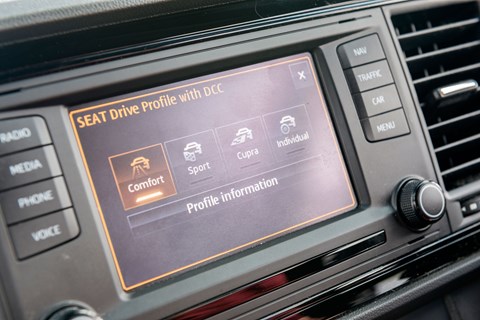
Month 2 running a Seat Leon Cupra 280: delving into the driving modes
Two months in and I’m thoroughly enjoying life with the Leon Cupra 280. I like the light and accurate steering with its fizz of feel, the connected but acceptably comfortable chassis, the clean snick of the gearshift, the engine’s flexibility and parsimony and its indecent turn of speed that can knock the wind out of tailgaters’ sails. If I’d committed to three years’ ownership, I wouldn’t be fretting.
I’ve been playing around with the driver-configurable modes. ‘The flag!’ shout my kids. ‘Press the flag, make it go fast!’ You can tweak the Leon’s steering weight, throttle response, no-cost adaptive dampers, engine sound and the aggressiveness of the mechanical LSD via four modes: Comfort, Sport, Cupra and Individual.
I think it’s testament to how right Seat has got these settings that a) I think every mode has a point and b) I haven’t yet bothered to programme Individual, which rather unravels a)… but, when I do, I reckon Comfort steering and damping, with Sport throttle, sound and diff settings would be ideal.
Mostly I use Comfort, but if I’m having fun I’ll engage Sport and feel that extra connection through the stiffer chassis. It doesn’t crash about, it’s just firmer, something I could tolerate all the time if I had just one setting. The louder Sport engine note is a little synthetic, but brings a huskier edge. The front suspension lacks sophistication when you hit a larger bump, so the super-stiff Cupra mode is best left for the track. Soon enough, that’s just where the Seat will be heading.
By Ben Barry
Month 1 running a Seat Leon Cupra 280: welcome to the fleet
The first press car I ever drove was a Seat Leon Cupra. It was bright yellow and offered Golf GTI-beating performance at a discount. Back in 2000, when the hot Golf was under par, that Leon was a frisky blast of Mediterranean air.
Fourteen years on and I now have a long-term Leon Cupra 280. Once again the Seat is rubbing its GTI sibling up the wrong way, and looks likely to beat its 3000 annual UK sales. Basing at £25,690, the Seat is £640 cheaper than the Golf, and makes 261bhp as standard from its 2.0-litre turbocharged four, or 276bhp in 280 spec (the near-identical PS figure). This compares rather favourably with the Golf’s 217bhp.
Don’t forget, the Leon briefly nicked the Nürburgring front-wheel-drive record from the Megane RS with a 7min 58.4sec lap. It’s easy to get blasé about such figures, but if most of us passengered on that kind of lap, we’d scratch our way through the side glass.
Like the Golf GTI, you can have your Leon in three- or five-door, and manual or dual-clutch flavours. Having two young kids, I went for the five-door Leon; 56% of buyers do. Is it me ageing, or do five-door hatches look better than they used to? I think the Leon looks fantastically pert with its angular slashes and squat, poised stance.
The full-bore 280 model carries a £1250 premium but you’d surely kick yourself if you didn’t step up to it; current take up is 90%, and it brings key extra equipment, so you can understand why. I dilly-dallied between the DSG and the manual, and so tried one of each. The DSG costs £1320 extra, drops the 0-62mph by 0.1sec to 5.7sec and disappointingly has no impact on mpg at 42.2mpg. It shifts quickly and with a pleasing bluff slap for a soundtrack and 71% of buyers spec it, but I like the tactility of the Leon’s controls, and the slick-shifting manual adds to that. A manual, five-door 280 it was, for £27,245.
Standard equipment for the 280 is strong, and offers further incentive for those eyeing a GTI: 19-inch alloys (GTI: £1k), mechanical limited-slip diff (part of the GTI’s £1k Performance Pack), full LED headlights (GTI: bi-xenons with LED DRLs), adaptive dampers (GTI: £815) and sat-nav (GTI: £750).
I didn’t spec this car, and while the options are sensiblish, they do add £2010, and every grand counts at this price. So my car upgrades the standard alcantara seats with leatherette bolsters to black, heated leather seats – still with fake leather bolsters – for £755; a Safety Pack brings yawn recognition and a rear-seatbelt warning bong at £115; Driver Assist (£295) includes automatically dipping headlights and a lane-assist gizmo for those lacking in lane discipline; and there’s Adaptive Cruise Control (£500) too.
Personally, I’d have done without all that and just specced the Seat sound system (it costs just £250 and its six-channel amp, ten-speakers and sub-woofer drown out the pained yelps of the aftermarket ICE industry) and the space-saver spare (£95), both of which my car has.
The Cupra didn’t fare particularly well during our hot-hatch battle – I didn’t attend that one – but so far I’m genuinely enjoying it. But the big question is: should you buy a Leon Cupra instead of a Golf GTI? I’ll be finding out over the next months.
By Ben Barry
